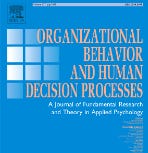New articles in OBHDP (May 1st, 2024)
These articles are part of the special issue on allyship, edited by Ellen Ernst Kossek, Jamie Ladge, Laura Little, Denise Loyd, Catherine Tinsley, and Alexis Washington.
Allyship in the fifth trimester: A multi-method investigation of women’s postpartum return to work
https://www.sciencedirect.com/science/article/abs/pii/S0749597824000220
Nitya Chawla, Allison S. Gabriel, Melanie Prengler, Kristie Rogers, Benjamin Rogers, Alyssa Tedder-King, Christopher C. Rosen
Postpartum mothers’ reentry into organizations contains a host of challenges. Whereas prior work on this topic has generally focused on how mothers can navigate these challenges, this article explores how colleagues can support and advocate for working mothers as they reenter. The authors first conducted an inductive study with postpartum mothers who had returned to work within the last five years. These interviews indicated that mothers valued allyship that assisted them with: (a) co-navigating the HR infrastructure, (b) creating physical and temporal spaces for motherhood, (c) validating the worker identity and, (d) validating the mother identity. The authors then conducted a study that demonstrated postpartum allyship bolsters mothers’ self-efficacy and reduces guilt. Taken together, these benefits of allyship led to positive outcomes in the workplace (decreased turnover intentions and postpartum depressive symptoms) and at home (increased sense of being a good family member). The authors provide several recommendations for how organizations can leverage these findings to support postpartum mothers; their work also suggests that all members of the organization (whether from a dominant or nondominant group) can be allies in the reentry process.
Garnering support for social justice: When and why is “yes” likelier for “allies” versus “disadvantaged group advocates”?
https://www.sciencedirect.com/science/article/pii/S0749597824000244
Deshani B. Ganegoda, Jigyashu Shukla, Debra L. Shapiro
Appeals to support social justice can come from a person belonging to the disadvantaged group (a disadvantaged group advocate; e.g., a woman calling for safe work spaces) or from a non-member of the disadvantaged group (an ally; e.g., a man calling for safe work spaces). This article explores whether social justice appeals lead to more positive behaviors and evaluations when communicated by allies versus disadvantaged group advocates. The authors theorized, and demonstrated over three studies, that an advocate’s effectiveness depended on whether the receiver of the appeal identified strongly or weakly with the group referenced in the social justice appeal. When the receiver strongly identified with the referenced group, appeals from disadvantaged group advocates were more effective. In contrast, when the receiver weakly identified with the referenced group, appeals from allies were more effective. The authors found that this effect occurred due to receivers perceiving themselves as more similar to either the ally or the disadvantaged group advocate. This perceived similarity triggered a positive chain reaction—increased message-credibility and empathy—that led to higher behavioral support for the advocated message. Taken together, these findings provide insight into how appeals to support social justice can be more effectively delivered.
p.s. if you can’t access the full-text let us (m-kouchaki@kellogg.northwestern.edu or mikebaer@asu.edu) know and we’d be happy to share a copy.


